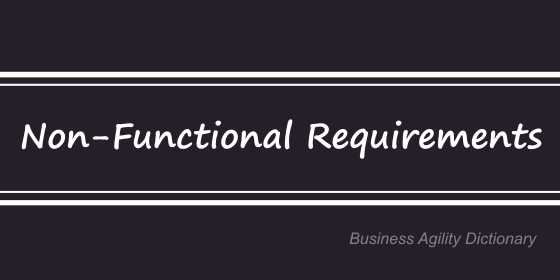Non-Functional Requirements

Non-functional requirements (NFRs), also known as quality attributes or system qualities, are the criteria that describe how a system should behave rather than what it should do. Unlike functional requirements, which specify the features and capabilities of a system, non-functional requirements focus on the overall performance, reliability, usability, security, and other characteristics that define the system’s behavior and quality.
Non-functional requirements are a critical aspect of software and product development. They define the quality attributes or characteristics that a software system or product must have, beyond just its core functionality. These requirements describe how a system should perform, rather than what it should do.
Aspects
Non-functional requirements encompass various aspects, including:
- Performance: Describes how the system should perform in terms of speed, response times, throughput, and resource utilization. For example, an NFR might specify that a web page should load in under two seconds.
- Security: Specifies the security measures and controls that need to be in place to protect the system from unauthorized access, data breaches, and other security threats.
- Scalability: Defines how the system should handle increasing workloads and user loads. It outlines how resources can be added to maintain or improve performance as the system grows.
- Reliability: Describes the system’s ability to function without failure or errors for a specified period. It includes requirements related to fault tolerance and availability.
- Availability: Specifies the system’s uptime requirements, including planned and unplanned downtime. It often includes measures to ensure high availability, such as redundancy and failover mechanisms.
- Usability: Defines the user experience and user interface requirements. This ensures that the system is user-friendly, accessible, and meets the needs of its intended users.
- Maintainability: Outlines requirements for the ease of maintenance, including code readability, modularity, and documentation. It ensures that the system can be updated and enhanced efficiently.
- Compatibility: Describes the system’s compatibility with various platforms, browsers, and external systems or interfaces.
- Regulatory and Compliance: Specifies requirements related to legal and regulatory standards that the system must adhere to. This includes topics such as data privacy regulations or industry-specific compliance standards.
Benefits
The benefits of defining and managing non-functional requirements effectively are numerous:
- Improved User Satisfaction: Meeting usability and performance requirements ensures a positive user experience. This leads to higher user satisfaction and adoption of the system.
- System Reliability: NFRs related to reliability and availability help ensure that the system is dependable and can be used when needed, reducing disruptions and downtime.
- Enhanced Security: Properly defined security requirements help protect sensitive data and prevent security breaches. Security related NFRs safeguard the system and keep the user information protected.
- Cost Savings: Addressing scalability and efficiency requirements early in the development process can lead to cost savings. The savings happen by avoiding expensive unnecessary rework or infrastructure changes later on.
- Compliance and Risk Mitigation: Meeting regulatory and compliance requirements reduces the risk of legal issues, fines, and reputational damage.
- Efficient Maintenance: Well-defined maintainability requirements make it easier to update and maintain the system over its lifecycle. This increases the pace of development and reduces the cost and effort of maintenance.
- Effective Resource Utilization: Performance and scalability requirements ensure that system resources are used efficiently, preventing overutilization and resource bottlenecks.
- Alignment with Stakeholder Expectations: Clearly documented NFRs help align the development team and stakeholders on the expectations for system quality, leading to a shared understanding of project goals.
- General Risk Mitigation: By addressing non-functional requirements upfront, you can identify potential risks and challenges early in the project and develop strategies to mitigate them. Learn more in out section about Risk Management.
- Employee Satisfaction: By spending less time on bug fixing and maintenance, the employees can engage with more fun and challenging work, which leads to higher engagement employee satisfaction.
In summary, non-functional requirements are crucial for delivering a software system that meets user expectations, complies with standards and regulations, and operates reliably and efficiently. When defined and implemented well, NFRs contribute to a successful and high-quality software product.
If you want to learn more about how to make better and more effective non-functional requirements, then simply let us know.